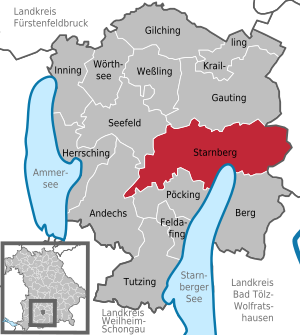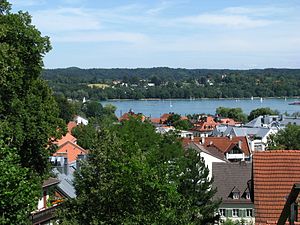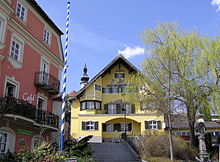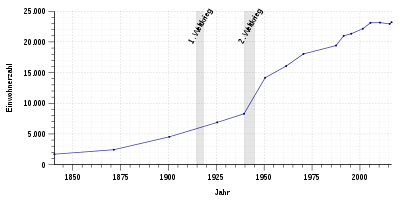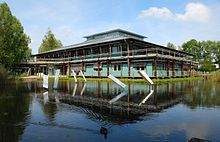Starnberg
| coat of arms | Germany map | |
|---|---|---|
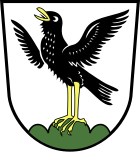
|
Coordinates: 48 ° 0 ' N , 11 ° 20' E |
|
| Basic data | ||
| State : | Bavaria | |
| Administrative region : | Upper Bavaria | |
| County : | Starnberg | |
| Height : | 588 m above sea level NHN | |
| Area : | 61.84 km 2 | |
| Residents: | 23,488 (Dec. 31, 2019) | |
| Population density : | 380 inhabitants per km 2 | |
| Postal code : | 82319 | |
| Area code : | 08151 | |
| License plate : | STA, WOR | |
| Community key : | 09 1 88 139 | |
| City structure: | 25 districts | |
City administration address : |
Vogelanger 2 82319 Starnberg, Germany |
|
| Website : | ||
| Mayor : | Patrick Janik (UWG) | |
| Location of the city of Starnberg in the Starnberg district | ||
Starnberg is the county seat of the same district within the administrative district of Upper Bavaria . Starnberg is located around 25 km southwest of Munich at the northern end of Lake Starnberg and is a place for excursions and relaxation.
Districts
The municipality has 25 officially named districts (the type of settlement is given in brackets ):
|
|
history
In 948/957, Starnberg's current district of Achheim was first mentioned in a document as "Ouiheim". The name "Starnberch", on the other hand, is not found until 1226. It refers to a settlement north of Ouiheim. In 1244 "Starnberch Castrum" was first mentioned, a castle which at that time was owned by the Counts of Andechs-Meranien . The name is said to come from the knight Wernher Miles de Starnberk, mentioned in 1208, a ministerial of the Counts of Andechs-Meranien, whose family is said to have sat at Starnberg Castle. After the Andechs-Meranier were ousted, the castle was owned by the Wittelsbach dukes from 1246 .
With the increasing importance of the nearby city of Munich as the residential city of the partial duchy of Bavaria-Munich, the original function of the old fortress as a defensive structure changed in the 15th century to become the summer residence of the Munich court society. Magnificent new buildings and gardens have resulted in a hunting lodge and pleasure palace, which - especially under Duke Albrecht V - became the focus of court life in the summer months with concerts, glittering festivities and hunts.
The charming location of the castle on the Würmsee (renamed Starnberger See in 1962) led to the construction of a ship park as early as 1490. It reached its climax with the construction of the Bucentaur , a magnificent ship that Elector Ferdinand Maria had built in 1662 for his wife Henriette Adelaide based on the Venetian model. Guests from all over Europe were invited to the legendary sea festivals and sea hunts that took place on this flagship of the courtly fleet until the middle of the 18th century . However, the Munich court now preferred the castles in Berg and Possenhofen , which were better suited for baroque ceremonies, fireworks and illuminations . The Starnberg Castle , the rooms of which had been devastated during the Thirty Years War and only partially restored, lost its importance as a summer residence. It was not used again until the beginning of the 19th century. In addition to the regional court , it now also housed the offices of the rent office and the forest office .
Today's Starnberg grew out of two neighboring settlements that were characterized by very different economic sectors. In the old village south of the castle, the name of which changed from Ouiheim to Aham to Achheim, fishing was traditionally at home. In Nieder-Starnberg, northeast of the castle (around today's Tutzinger-Hof-Platz), mainly craftsmen and servants of the Munich court had settled. Benefiting from the Munich – Starnberg railway line, which was opened in 1854, the until then small community developed into the most important town on the lake in the 19th century, and in 1912 it was awarded the “highest approved classification of the rural community of Starnberg in the class of towns with an urban constitution”.
Urban development
At the beginning of the 19th century, wealthy families discovered the beauty of the landscape around Lake Starnberg and had the first villas built on the lakeshore as summer residences. Among them was building officer Johann Ulrich Himbsel , who settled in Leoni in 1827 and who, as the founder of steam navigation on Lake Starnberg, actually gave the impetus for the rapid development of the village of Starnberg in the second half of the 19th century. Very early on, Himbsel saw the economic importance that had to result from the connection between the nearby city and free, untouched nature. After long unsuccessful efforts under Ludwig I , however, it was not until 1848 that Maximilian II gave him permission to build a steamship and a railway line between Munich and Starnberg. Three years later, the “Maximilian” saloon steamer, built for 300 passengers, was launched in Starnberg and numerous Munich day trippers who traveled through Forstenrieder Park in carriages and wagons enthusiastically embraced this new opportunity to spend their free time. In order to achieve better utilization of the ship, Himbsel began to expand the Munich – Starnberg railway line at his own expense. In 1854 the line was opened with a pageant that started in the capital of the Kingdom of Bavaria and ended in a small rural community with 65 scattered properties, which the contemporary writer Heinrich Noë describes as follows: “The village of Starnberg as a place to stay also has other disadvantages ... I advise everyone who wants to travel the lake not to stay there a minute longer than the connections with the railroad or steamboat entail, because in the nest they do not find any object to see, but usually one annoying. ”
Himbsel probably saw it that way too, because he laid the track in such a way that the day trippers could get to his steamship by the shortest possible route from his train. A circumstance that still stirs the minds today, because the urban developmentally unfavorable location of the embankment separates the city from the lake.
With the connection to Munich now available, Alt-Starnberg changed in a very fast and impressive way. The possibility of working in the city and living by the lake led to a real construction boom in the years to come. The town villas and country houses that professors, lawyers, artists and merchants were now having built were no longer intended to serve only as summer homes, they were the main residence of families. At the same time the town center developed. The local construction companies and craftsmen, who earn well from the brisk construction activity, built new homes here. The vacant lots on the old Weilheimer Landstrasse (today Hauptstrasse) also slowly filled up, allowing the two settlement centers of Achheim and Nieder-Starnberg below the castle hill to grow together. With the development of the "Au" begun around 1870, the new residential areas on Maximilianstrasse and Kaiser-Wilhelm-Strasse were created. The improved infrastructure - the sewerage system began in 1890 and the municipality's first power station went into service in 1897 - attracted further building owners, whose villas and parks on the surrounding hills completely changed the landscape. In 1900, the once 65 properties had become 384 in which 4,531 people lived.
Excursion traffic had also developed very strongly thanks to the railway line. After the war of 1870/71 , the steamer “Maximilian” carried one million passengers in three years. In 1872 the steamship "Ludwig" was put into operation. It was followed by the steamers “Bavaria” (1878), “Wittelsbach” (1886) and Luitpold (1890). The inns that were built to take care of the day trippers were soon no longer sufficient, as more and more guests not only wanted to go out to the country, but also to spend their holidays in Starnberg. Up to the turn of the century, large, elegant hotels were built in addition to guesthouses, which gave the place the flair of a seaside resort due to their appearance and the high-ranking public staying there. Sailing regattas, promenade concerts and, above all, a luxuriously equipped bathing establishment provided entertainment. In 1905, the “Undosa” , the first wave pool in Germany, emerged as a special attraction . In 1911, at the height of Starnberg's time as a seaside resort and resort, 1,268 spa guests were registered with 42,000 overnight stays and 2,870 overnight stays.
Today, little reminds of the atmosphere in Starnberg at the turn of the century. The First World War heralded a turning point. Well-to-do guests came only a few times, and summer vacationers who were looking for peace and quiet preferred places that were away from the day-trip traffic. Because of the short and intensive history of development from a small village to a town (1912), an actual town center could never develop, the necessary demolition of many old buildings and the buildings in the style of a new era changed the face of Starnberg particularly lastingly.
Today's district town of Starnberg has developed from a tourist resort into a diversified business location and the cultural center of the five lakes that surround it . The core city (without the incorporated districts) has now reached a little more than 11,000 inhabitants.
Incorporations
Up until the beginning of the 19th century, Starnberg's field size was only 6.81 km². 1803 Although vineyards was added which until the secularization the monastery Schäftlarn had listened. The actual increase in the area to today's size of 61.92 km² did not take place until the 1970s. Hanfeld was incorporated on January 1, 1972, and on May 1, 1978, on the occasion of the municipal area reform, six other formerly independent municipalities were incorporated with the areas previously administered by them.
Districts of the city of Starnberg with the year of incorporation and the size of the corridor:
Hadorf (1978, 6.93 km²)
Hanfeld with Mamhofen (1972, 5.58 km²)
Leutstetten with Einbettl , Mühlthal , Oberdill , Petersbrunn and Schwaige (1978, 7.68 km²)
Percha with Buchhof , Heimathshausen and Selcha (1978, 6 , 07 km²)
Perchting with Landstetten , Jägersbrunn and Sonnau (1978, 11.36 km²)
Rieden (1803, 1.83 km²)
Söcking (1978, 8.17 km²)
Wangen with Fercha, Schorn , Unterschorn and Wildmoos (1978, 7 , 49 km²)
Pictures from the incorporated towns and hamlets
Hadorf , Church of St. John the Baptist
Hanfeld , Church of St. Michael
Landstetten , St. Jakobus Church
Percha, Church of St. Valentine
Perchting , parish church of the Visitation of the Virgin Mary
Vineyards , Church of St. Peter and Paul
Söcking , parish church of St. Ulrich
Cheeks, St. Ulrich Church
Population development
Between 1988 and 2018 the city grew from 19,845 to 23,498 by 3,653 inhabitants or 18.4%.
|
|
politics
mayor
The first mayor of the city of Starnberg has been Patrick Janik (UWG) since May 1st, 2020 . He took over the office from Ms. Eva John (BMS) (term of office 2014 to 2020). Before that, Messrs Ferdinand Pfaffinger (UWG) (term of office 2002 to 2014) and Heribert Thallmair (CSU) (term of office 1969 to 2002) held the office of First Mayor.
City council
| year | CSU | BMS | SPD | Green | FDP | BLS | WPS | UWG | DPF | total | voter turnout |
|---|---|---|---|---|---|---|---|---|---|---|---|
| 2020 | 8th | 4th | 2 | 6th | 2 | 2 | 3 | 3 | - | 30th | 59.4% |
| 2018 | 6th | 3 | 2 | 3 | 2 | 3 | 4th | 4th | 3 | 30th | - |
| 2015 | 6th | 6th | 2 | 3 | 2 | 2 | 6th | 3 | - | 30th | 48.8% |
| 2014 | 7th | 5 | 2 | 3 | 2 | 2 | 5 | 4th | - | 30th | 56.3% |
| 2008 | 8th | - | 3 | 3 | 2 | 8th | - | 6th | - | 30th | 58.8% |
| 2002 | 12 | - | 4th | 2 | 2 | 5 | - | 5 | - | 30th | 57.5% |
BLS = Citizens List Starnberg BMS = Bündnis Mitte Starnberg WPS = Pro Starnberg Voting Association UWG = Independent Voting Association DPF = The Free Party
- 2015: Due to the unclear origin or whereabouts of voting slips, the Starnberg District Office declared the 2014 election of the Starnberg City Council to be invalid. A new election took place on April 19, 2015.
- 2018: Changes through party change .
tax income
The municipal tax revenue in 2012 amounted to approx. 29.255 million euros, of which the trade tax revenue (net) amounted to the equivalent of 14.367 million euros.
Town twinning
Starnberg has had an active city partnership with the French city of Dinard since 1977 . Every year a delegation of citizens travels to the other city. Student exchanges are organized between the two cities.
Sponsorship
Starnberg is the godfather city of the submarine U 34 of the German Navy , stationed at the naval base Eckernförde .
Economy and Infrastructure
Purchasing power
The Starnberg district and the associated town Starnberg were loud GfK market research for many years at the forefront of purchasing power statistics . According to the GfK purchasing power study for 2013, the Starnberg district, with an available per capita income of € 30,509, took over the top position from the Hochtaunus district for the first time since 2008 . At 33,102 euros per capita purchasing power, it was 44 percent above the national average in 2018, making it the top nationwide.
Economy including agriculture and forestry
According to official statistics, there were 82 employees at the place of work in 1998 in the field of agriculture and forestry, 1,450 in the manufacturing sector and 2,193 in the trade and transport sector. In other economic sectors, 4,271 people were employed at the place of work subject to social security contributions. There were a total of 6647 employees at the place of residence subject to social security contributions. There were three companies in the manufacturing sector and 40 companies in the main construction sector. In addition, in 1999 there were 59 farms with an agriculturally used area of 1754 ha, of which 868 ha were arable land and 882 ha were permanent green space. An important employer is Houdek , one of the largest food producers in the Free State. Another large company based in Starnberg is Aenova . The Aenova Group is one of the largest contract manufacturers for the pharmaceutical industry in Europe.
traffic
Road traffic
Starnberg is on the federal highway 2 , which has been replaced by a motorway between Munich and Starnberg (transition to the B 2 at the end of the Starnberg federal motorway 952 , which branches off the federal motorway 95 Munich - Garmisch-Partenkirchen ). Since all car traffic to the west bank of the lake and to the Weilheim - Schongau district runs through Starnberg, the volume of traffic through the city is correspondingly high. The situation on the main road is exacerbated by the fact that almost all inner-star traffic is fixed on the main road and alternative routes in the village are either blocked or made unattractive through traffic calming or other measures.
A road tunnel under the town center has been discussed since 1987. A planning approval decision for such a tunnel has been in place since 2007. Due to a changed majority, the city council commissioned the administration in July 2014 to present concepts for a bypass road as an alternative to a tunnel. On February 20, 2017, the construction of the B2 tunnel was approved by the city council. In the same decision, the planning of a bypass was also commissioned, which is to be implemented as a supplement to the tunnel after its completion. Due to the current legally binding planning approval decision for the tunnel and as a result of the funding commitment by Federal Transport Minister Alexander Dobrindt , tunnel construction is now expected to start in 2019. This should be completed in 2025 and have a length of 1878 meters.
Rail transport
In 1854 the Royal Bavarian State Railways opened a railway line from Munich to Starnberg , which was extended to Tutzing and Weilheim in 1865 . The railway line was built to promote excursion traffic from Munich and to the steamboats on the lake. It therefore runs between the city and the lake to enable easy transfer from the train to the ships. However, this cut the city off from the water. At the time of construction, the swampy bank area was owned by the state and could therefore be built on after it had been drained without expensive taking over properties that had already been allocated. The urban planning effects of this decision only became clear decades later.
Starnberg has been connected to the Munich S-Bahn network since 1972 . In addition to the four-track Starnberg train station from 1854, which is located directly on the lake shore, the new Starnberg Nord stop has existed since June 10, 2001 . Both stations are served every 20 minutes by the S6 line from Tutzing to Ebersberg . In addition, regional trains usually stop every hour from Munich main station via Tutzing to Kochel or Weilheim at the old Starnberg station.
Bus transport
The following city, regional and express bus routes operate in the city of Starnberg in the Munich Transport and Tariff Association (MVV).
City bus routes ( blue ) / express bus routes ( green ) / regional bus routes ( red )
| line | Line course | Traffic Company |
|---|---|---|
| X900 | Starnberg North - Gilching - Argelsried - Fürstenfeldbruck - Buchenau | Regionalverkehr Oberbayern GmbH (RVO) |
| 901 | Starnberg North - Starnberg (See) Bhf. - Rosenstrasse - Hofbuchetstrasse - Klinikum-MediCenter | Waibel Bus GmbH |
| 902 | Starnberg North - Starnberg (See) Bhf. - Klinikum-MediCenter - Esterbergstrasse - Söcking, Bründelwiese | Waibel Bus GmbH |
| 903 | Starnberg (See) Bhf - Starnberg Clinic - Söcking, Mitte - Hadorf - Perchting, Ort | Waibel Bus GmbH |
| 904 | Starnberg North - Am Schloßhölzl - Wangen - Neufahrn (Munich) - Hohenschäftlarn Bhf. | DB Regio Bus Bayern GmbH (DRB) |
| 949 | Starnberg North - Am Schloßhölzl - Petersbrunn - Mühltal - Gauting, Magdalenenstraße - Gauting Bhf. | Demmelmair Omnibusbetrieb GmbH & Co KG |
| 950 | Starnberg North - Oberalting - Herrsching Bhf. | Geldhauser Linien- und Reiseverkehr GmbH & Co. KG / Regionalverkehr Oberbayern GmbH (RVO) |
| 951 | Starnberg North - Andechs - Herrsching Bhf. | Geldhauser Linien- und Reiseverkehr GmbH & Co. KG / Regionalverkehr Oberbayern GmbH (RVO) |
| 955 | Starnberg North - Egerer Straße - Oberbrunn - Hochstadt, Waldsiedlung - Oberpfaffenhofen - Weßling Bhf | Demmelmair Omnibusbetrieb GmbH & Co KG |
| 961 | Starnberg North - Kempfenhausen - mouth - Ammerland | DB Regio Bus Bayern GmbH (DRB) |
| 964 | Starnberg (See) Bhf. - Pilotystraße, Possenhofen Bhf. - Pöcking, Parkstraße - Wieling, industrial area | Geldhauser Linien- und Reiseverkehr GmbH & Co. KG / Regionalverkehr Oberbayern GmbH (RVO) |
| 975 | Starnberg (See) Bhf. - Starnberg North - Berg - Wolfratshausen Bhf. | DB Regio Bus Bayern GmbH (DRB) |
Bavarian maritime shipping
In addition to the jetty, Bayerische Seenschifffahrt also has a port in Starnberg with an attached shipyard, where the Starnberger See section with around 30 employees looks after the six passenger ships that operate on the Starnberg Lake, including the MS Starnberg catamaran with a length of 54 m and space for 800 people.
education
Kindergartens and schools
- Kindergartens : 18
- Primary schools : 3
- Middle schools : 1 (Starnberg Middle School)
- Grammar schools : 1 (Starnberg grammar school)
- Special schools : 2 (Franziskus school - school for individual coping with life, Fünfseen school - school for individual learning support)
- Montessori School (private school)
- Munich International School (private school)
- Vocational schools : 2 (State Vocational Center Starnberg, IB Medical Academy Starnberg)
- Technical college (faculties of social affairs as well as economics and administration)
- University of Applied Sciences for Public Administration and Justice in Bavaria (Department of Justice)
- Adult Education Center Starnberger See
Diver training center Percha
The Percha diver training center has been located in Percha , right on Lake Starnberg, since 1960 , and is one of two German armed forces training centers for the training of army divers. Above all, pioneer divers are trained in the center. The training center includes two training platforms that occasionally float on the open sea, which are primarily used for deep diving training for pioneer divers. If necessary, divers from the technical relief organization are also trained.
Sports
On its website, the city of Starnberg offers a list of over fifty clubs in which people have come together for joint sporting activities. Particularly noteworthy are eight gymnastics and sports clubs with a wide range of different sports, including more unusual areas such as square dance . The football team of TSV Perchting-Hadorf is known nationwide, the 2014/15 in the A class and that of the FT Starnberg 09, which plays in the district class.
The fact that sport shooting is very popular is shown by the fact that Starnberg is home to seven shooting clubs.
However, the largest number of different clubs relates to Lake Starnberg . Some of them - such as the Munich rowing and sailing club "Bavaria" from 1910, the Munich Yacht Club or the Bavarian Yacht Club - were founded at the time when Starnberg was still a seaside resort. Thanks to the initiative of these clubs, many regattas with an international line-up in the summer months .
Two 18-hole golf courses offer another option for sporting activities. One of them is in the Hadorf district. Its specialty is that in winter, depending on the weather, trails are groomed on the wide area , which also allow cross-country skiers to practice their sport.
Equestrian sport plays a major role in the rural areas of the city . In 2010 there were 462 cattle compared to 409 horses. In addition, there is the pension horse keeping, which by taking on services such as feeding, manure and litter also allows riders with urban residence to keep a horse.
Tennis courts and a water park are available for people who prefer to do sports in private. Cyclists and skaters use the many existing paved rural roads ; Hikers and joggers, on the other hand, love the Mühlthal and the moraine hills in the western part of the city for their excursions .
Culture
Architectural monuments
Buildings
- Starnberg Castle
- Rococo church of St. Josef with high altar by Ignaz Günther
- St. Peter and Paul , small church in Rieden with grave of Princess Mathilde of Bavaria
- Leutstetten Castle
- Lake Starnberg Museum
- Villa rustica , remains of a former Roman manor
- District Office of the Starnberg district
- Marienbrunnen
- Memorial by sculptor Walter Habdank in the district of Peter Brunn on the death march of 6887 prisoners of the Dachau concentration camp reminds
- Catholic branch church St. Michael in the Hanfeld district with a Renaissance altar
- Catholic curate church St. Ulrich in Wangen
More Attractions
- Lake promenade
- Castle garden
- Achheimviertel settlement core
- Tutzinger-Hof-Platz settlement core
Personalities
Mayor of Starnberg
- 1844–1845: Alois Ludwig Deiglmeier, pharmacist
- 1845-1850: Simon Popp
- 1850: Schonger, pharmacist
- 1870–1898: Ludwig Rupprecht
- 1898: Franz Xaver Rettenberger, tradesman
- 1898–1906: Karl Emslander, brewer
- 1906–1913: Franz Xaver Rettenberger, tradesman
- 1913–1919: Jakob Tresch, businessman
- 1919–1921: Josef Fischhaber, master builder
- 1921–1933: Josef Jägerhuber, businessman, honorary mayor from April 1933
- 1933–1943: Franz Buchner , surveyor
- 1943–1945: Hans Deuschl , doctor
- 1945–1946: Karl Goldaté, school director
- 1946–1950: Otto Gaßner, master builder
- 1950–1960: Eduard Süskind, bank director, honorary mayor
- 1960–1969: Rudolf Widmann , lawyer, later member of the Bavarian state parliament and district administrator for the Starnberg district
- 1969–2002: Heribert Thallmair , lawyer, honorary citizen from 2003
- 2002–2014: Ferdinand Pfaffinger , insurance salesman, former mayor since 2014
- 2014–2020: Eva John
- since 2020: Patrick Janik
Many of the former mayors have had the honor of having a street in the city named after them.
sons and daughters of the town
- Franz Maria Luitpold of Bavaria (1875–1957), Bavarian prince from the Wittelsbach family
- Friedrich Wend zu Eulenburg (1881–1963), politician, landowner and farmer
- Franz Buchner (1898–1967), NSDAP member of the Reichstag and from 1933 to 1943 mayor of Starnberg
- Paula Braend (1905–1989), actress
- Heinrich Walter Cassirer (1903–1979), philosopher
- Oskar Dimroth (1906–1955), actor
- Rudolf Widmann (1929–2000), FDP - member of the state parliament , from 1960 to 1969 mayor of Starnberg and from 1969 to 1996 Starnberg district administrator
- Nikolaus Gerhart (* 1944), sculptor and rector of the Academy of Fine Arts in Munich
- Marianne Sägebrecht (* 1945), actress and cabaret artist
- Elfi Hartenstein (* 1946), writer
- Rainer Frieb (1949–2017), actor
- Luitpold Prince of Bavaria (* 1951), great-grandson of the last King of Bavaria, Ludwig III.
- Peter Herrmann (* 1954), film producer
- Oskar Roehler (* 1959) film director, journalist and author
- Marion Grillparzer (* 1961), German journalist and author in the field of nutrition. She became known with the Glyx Diet in 1999.
- Karl Habsburg-Lothringen (* 1961), Austrian politician, head of the House of Habsburg since January 1, 2007
- Lisette Gebhardt (* 1963), philologist, Japanese studies and university lecturer
- Georg Habsburg-Lothringen (* 1964), Hungary's special ambassador
- Rebecca Abe (* 1967), writer and illustrator
- Maike Conway (* 1967), documentary filmmaker and director
- Heike Grimm (* 1967), political and economic scientist
- Miriam Vogt (* 1967), former German ski racer
- Winnie Forster (* 1969), computer game journalist
- Isabella von Lospichl (* 1970), artistic gymnast
- Mona Steigauf (* 1970), track and field athlete and Olympic participant
- Martina Veh (* 1971), opera director
- Herbert Ulrich (actor) (* 1971), actor
- Georg Melich (* 1979), actor
- Max von Mosch (* 1980), jazz musician
- Justus Scharowsky (* 1980), hockey player
- Martina Heinlein (* 1981), field hockey player
- Adrian Hermann (* 1981), religious scholar and university professor
- Sabrina Kruck (* 1981), ice hockey player
- Golo Euler (* 1982), actor
- Max Frankl (* 1982), jazz musician
- Dragan Paljic (born 1983), football player
- Sophie Rogall (born 1983), actress
- Adrian Sutil (* 1983), racing car driver
- Sara Goller (* 1984), beach volleyball player
- Franziska Hartmann (* 1984), theater and film actress, voice actress
- Maximilian Hauser (* 1984), beach volleyball player and volleyball trainer
- Andreas Kruck (* 1984), ice hockey player
- Benedikt Doranth (* 1987), volleyball and beach volleyball player
- Vroni Huber (* 1988), soccer player
- Alessandra Jovy-Heuser (* 1991), volleyball player
- Michelle von Treuberg (* 1992), actress
- Tatjana Paller (* 1995), racing cyclist
- Clemens Wickler (* 1995), volleyball and beach volleyball player
- Tobias Kircher (* 1996), ice hockey player
Other personalities connected to the city
- Johann Friedrich Wilhelm Adolf Ritter von Baeyer (1835–1917), German chemist, died in Starnberg
- Heidi Brühl (1942–1991), German pop singer and actress, died in Starnberg
- Heinrich Gans (1890–1973), agricultural scientist and painter, died in Starnberg
- Fritz Gartz (1883–1960), German expressionist painter . The Fritz-Gartz-Weg in Starnberg is named after him
- Georg Arnold-Graboné (1896–1982), German impressionist, lived and died in the Starnberg district of Percha
- Jürgen Habermas (* 1929), together with Carl Friedrich von Weizsäcker, headed the Max Planck Institute for research into the living conditions of the scientific and technical world from 1971 to 1981
- Johannes Heesters (1903–2011), Dutch actor and operetta star, lived and died in Starnberg-Söcking.
- Bernhard Heinzmann (1903–1942), Catholic priest and staunch opponent of Nazi ideology, was a chaplain in Starnberg in 1930
- Otto Michael Knab (1905–1990), critical journalist, editor, lived in Starnberg from 1924 until he emigrated in 1934. As an author, he was instrumental in the Heimatbuch Stadt Starnberg .
- Karl Lieffen (1926–1999), German stage, film and television actor, died in Starnberg
- Richard Lipps (1857–1926), German landscape and architecture painter, lived in Starnberg from 1895 until his death in 1926
- Ludwig III. of Bavaria (1845–1921), last Bavarian king; Expansion of the land around Leutstetten Castle into an agricultural model estate
- Herbert Marcuse (1898–1979), German-American sociologist and philosopher, died in Starnberg
- Gustav Meyrink (1868–1932), Austrian writer , died in Starnberg
- Claus Nageler (1943–2017), sculptor, lived in Starnberg
- Erwin Piscator (1893–1966), German director and theater innovator, died in Starnberg
- Georg Queri (1879–1919), Bavarian local poet and writer, lived in Starnberg and is buried there
- Lilo Ramdohr (1913–2013), author and painter, member of the White Rose resistance group , lived in Starnberg since 1950, died there
- Rupprecht von Bayern (1869–1955), the last Bavarian Crown Prince, died in Leutstetten Castle
- Heinrich Wolfgang Seidel (1876–1945), pastor and writer, died in Starnberg
- Heribert Thallmair (* 1936), former mayor of Starnberg and last president of the now abolished Bavarian Senate
- Georg Thomalla (1915–1999), German actor and voice actor, died in Starnberg
- Brigitte Weigert (1934–2007), painter and table tennis player, lived in Starnberg
- Carl Friedrich von Weizsäcker (1912–2007), physicist and philosopher, lived and worked here from 1970 until his death
- Kira Weidle (* 1996), German ski racer (downhill and Super-G), drives for SC Starnberg
Honorary citizen
literature
- Starnberg City History (9 volumes). Kulturverlag City of Starnberg.
- Astrid Amelungse-Kurth, Annette Kienzle: Culture walk through Starnberg . Kulturverlag Starnberg, 2006, ISBN 978-3-935736-15-2 .
- Otto Michael Knab , Hans Zellner, Hans Beigel: Heimatbuch Stadt Starnberg . Ed .: City of Starnberg. Starnberg 1972, DNB 730500314 .
Web links
- Entry on the Starnberg coat of arms in the database of the House of Bavarian History
- Stephan Lebert, Stefan Willeke: The Starnberg Republic (Nowhere in Germany do more millionaires live than on Lake Starnberg. The state, that's them - the mayor also fears their lawyers. Visiting the upper class who lives as they please.) . Article from Die Zeit , December 20, 2006 No. 52.
- Starnberg: Official statistics of the LfStat
- TV documentary: Houses in the Knittl style: timelessly beautiful. (11 minutes) Bavarian TV, March 23, 2019, accessed on March 23, 2019.
Individual evidence
- ↑ "Data 2" sheet, Statistical Report A1200C 202041 Population of the municipalities, districts and administrative districts 1st quarter 2020 (population based on the 2011 census) ( help ).
- ^ Community Starnberg in the local database of the Bavarian State Library Online . Bavarian State Library, accessed on September 9, 2019.
- ↑ Heimatbuch Stadt Starnberg , publisher: Stadt Starnberg, January 1972
- ↑ Full steam ahead to the lake - 150 years of the Munich – Starnberg railway line , Kreissparkasse Munich Starnberg (ed.)
- ↑ Villas and residential houses from the construction phase around 1900
- ↑ a b Landpartie - museums around Munich, day trippers - summer visitors - new citizens, ISBN 3-930941-33-3 , 2002
- ↑ Rustikal and Dominikal tax register 1809/12, State Archives Munich.
- ^ Wilhelm Volkert (ed.): Handbook of Bavarian offices, communities and courts 1799–1980 . CH Beck, Munich 1983, ISBN 3-406-09669-7 , p. 576 .
- ↑ Bavarian State Office for Statistics and Data Processing , accessed on July 23, 2014.
- ↑ City Council , City of Starnberg, accessed on April 10, 2018.
- ↑ Purchasing power Germany 2018. In: https://www.gfk.com/de/ . GfK Growth from Knowledge, December 12, 2017, accessed on May 3, 2019 .
- ↑ Unanimously for the search for a tunnel alternative , merkur-online.de
- ↑ 19 to 12 votes: Starnberg opts for B2 tunnel . In: https://www.merkur.de . February 21, 2017 ( merkur.de [accessed February 21, 2017]).
- ↑ City of Starnberg on the topic of sea connections , seeanbendung-starnberg.de, accessed on July 28, 2014.
- ^ Otto Fritscher: Diving like James Bond , Starnberger local edition of the Süddeutsche Zeitung from 8/9. October 2016
- ↑ Memorial sites for the victims of National Socialism. A documentation , volume 1. Federal Agency for Civic Education, Bonn 1995, ISBN 3-89331-208-0 , p. 194.
- ↑ Heimatbuch Stadt Starnberg , Stadt Starnberg (ed.), 1972, page 255 for the mayors 1844–1969

